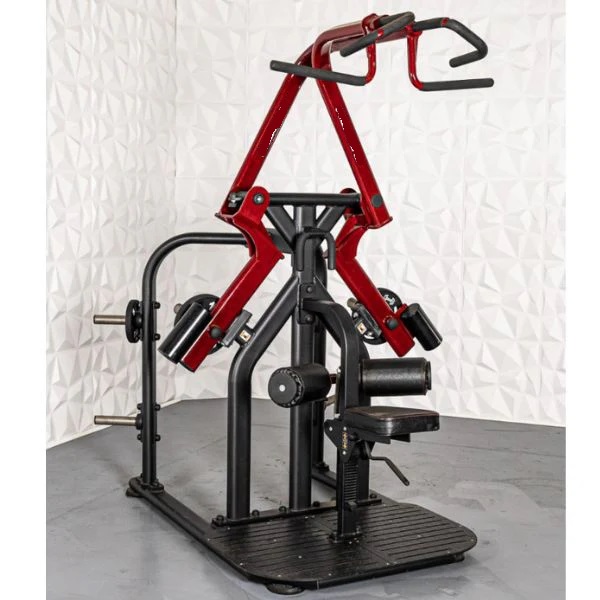I never really paid much attention to the rotary lat pulldown—until I saw a Reddit post asking if doing just lat pulldown variations was enough to train your upper body.
Honestly, that post got me thinking. I’d just started messing around with the rotary lat pulldown at the gym—it felt awesome. But I still wasn’t sure if it was doing much outside my lats, you know?
So I decided to dig in a little. What exactly does the rotary lat pulldown hit? How is it different from the regular version? And more importantly—can either one really carry your upper-body training?
How the Rotary Lat Pulldown Compares to the Classic Version
What Even Is a Rotary Lat Pulldown?
The rotary lat pulldown isn’t some cable hack or tweak—it’s an actual machine you’ll see in a lot of commercial gyms. The key difference? Independent rotating arms instead of the usual fixed bar.
So instead of pulling one bar straight down in front of you, you’re pulling each arm separately, often on a smooth arc. It kinda mimics how your arms naturally move. Honestly, it just feels better—especially if your shoulders are cranky or you’ve dealt with joint issues.

How It Felt vs. the Traditional Pulldown
When I tried the rotary version, the first thing I noticed was how smooth the movement felt. Like, way more natural than the straight bar. I didn’t feel locked into one path. Plus, I could finally stop my stronger side from doing all the work.
That said, the regular pulldown still wins when it comes to going heavy. It’s stable, simple, and easy to load up. So if you’re chasing numbers, it definitely has its place.
What Muscles Are You Actually Training?
So here’s the big question—what muscles are we really working here? Good news: both machines hit a solid list of upper-body muscles.
Let me break it down in a quick table:
| Muscle Group | Rotary Lat Pulldown | Traditional Lat Pulldown |
|---|---|---|
| Lats | ✅ Primary focus | ✅ Primary focus |
| Teres Major | ✅ Clearly engaged | ✅ Clearly engaged |
| Biceps | ✅ Active throughout | ✅ Active throughout |
| Rear Delts | ✅ Slightly more active | ✅ Still involved |
| Mid/Lower Traps & Rhomboids | ⚠️ Depends on form | ⚠️ Depends on form |
| Core/Stabilizers | ✅ More active (unilateral control) | ❌ Not really engaged |
| Shoulder Stabilizers | ✅ More activation due to arc | ❌ Less demand |
Basically, they both crush your lats and upper back. But the rotary machine adds a bit more control and balance, especially side-to-side. It’s a solid pick if you’ve got imbalances—or just want to move better, not just heavier.
- Do They Train the Whole Upper Body?
Not really. Basically, both the rotary and traditional pulldown hit your pulling muscles—so mostly lats, biceps, and rear delts. However, they don’t really touch your chest, triceps, or front delts much.
So, you’re not hitting the entire upper body. So yeah, you’ll still need presses and other pushes to round out your upper-body work.
- Which One’s Better?
Honestly, it depends on your goal. Personally, I go for the rotary version when I want more control—or if I’m trying to fix one side lagging behind. But when it’s time to go heavy and build strength, I stick with the traditional machine. Both have a spot in the gym.
Related Articles:
How I Started Using the Straight Arm Lat Pulldown
FAQs about Rotary Lat Pulldown
The most effective lat pulldown depends on your fitness goals and individual needs. The rotary lat pulldown is highly efficient for isolating the latissimus dorsi and engaging secondary muscles like the traps, rhomboids, and biceps. Its rotary motion provides a natural range of movement, ensuring consistent tension and reducing strain on joints.
For individuals seeking back width, wide-grip lat pulldowns may be more beneficial. Close-grip variations target the lower lats and improve pulling strength, while reverse grip pulldowns activate the biceps more effectively.
Ultimately, incorporating a mix of rotary and traditional lat pulldowns into your workout routine ensures comprehensive back development. At Leadman Fitness, we recommend tailoring your exercise selection to your specific goals, whether it’s muscle growth, endurance, or rehabilitation.
The primary difference between a lat pulldown and a reverse lat pulldown lies in the grip position. In a standard lat pulldown, an overhand grip is used, emphasizing the upper lats and creating back width. This variation is ideal for building a V-shaped back and improving overall pulling strength.
In contrast, a reverse lat pulldown employs an underhand grip, shifting the focus to the lower lats and biceps. The reverse grip also allows for a greater range of motion in the arms, enhancing flexibility and control during the exercise.
Both exercises are effective for back development but serve slightly different purposes. Incorporating both into your routine ensures balanced muscle activation and strength improvement. At Leadman Fitness, we advocate for grip variation to target multiple areas of the back effectively.
The key difference between a standard lat pulldown and a leverage lat pulldown is in the machine’s mechanics and motion. A lat pulldown uses a pulley system with adjustable weights, providing smooth and consistent resistance throughout the movement. It’s versatile and suitable for a wide range of fitness levels.
A leverage lat pulldown, on the other hand, uses a lever mechanism. This design mimics free weight movements, creating a more natural resistance curve. The resistance increases as the lever moves closer to the body, simulating real-life pulling motions.
Leverage machines are often preferred for functional training and advanced strength development. However, standard pulleys are more accessible and user-friendly for beginners. At Leadman Fitness, we recommend choosing based on your training goals and experience level.
Leaning back excessively during a lat pulldown can compromise form and increase the risk of injury. When you lean too far back, the focus shifts from the lats to other muscle groups, such as the lower back. This reduces the exercise’s effectiveness and can lead to unnecessary strain on the spine.
A slight backward lean, no more than 30 degrees, is acceptable for stabilizing the movement and allowing a full range of motion. Keep your chest lifted and core engaged to maintain proper alignment throughout the exercise.
At Leadman Fitness, we emphasize the importance of controlled movements and proper posture to maximize muscle engagement and prevent injury. If you find yourself leaning excessively, reduce the weight and focus on technique. Prioritizing form ensures safe and effective training with the rotary lat pulldown or any other variation.

Hi, I’m the editor here at Leadman Fitness. We’re a manufacturer focused on producing top-quality barbells, plates, kettlebells, dumbbells, and strength training gear. I’ve been into sports and fitness for years, and I know my way around all kinds of gym equipment—both from using it and helping create it.
I spend a lot of time understanding the real problems people run into in the gym—whether it’s beginners trying to pick the right gear or experienced lifters looking for something more durable. I stay in close touch with our production team and talk directly with other equipment makers, so we’re always improving based on what real lifters and coaches are looking for.
What I share comes from hands-on experience—stuff that actually helps people train better, not just in theory, but in real gyms.
